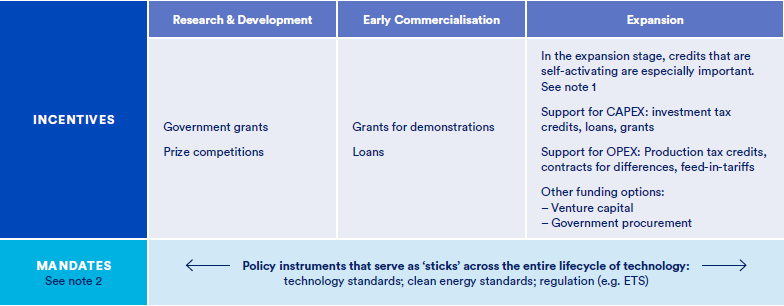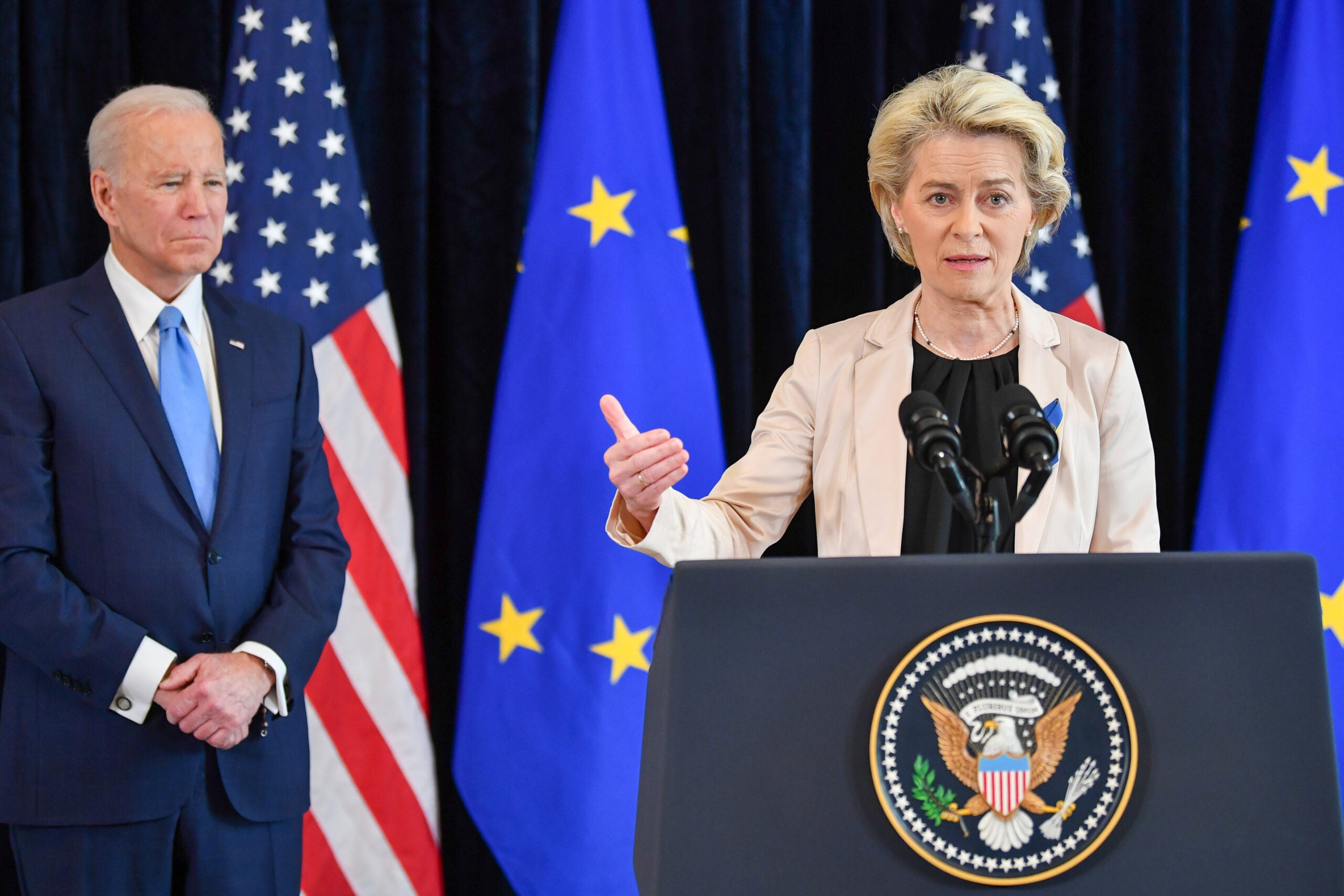In spite of the differences between political systems in the US and Europe, transatlantic policymakers can and should learn from each other. Recent US policy innovations – the Inflation Reduction Act (IRA), the Bipartisan Infrastructure Law and the Energy Act of 2020 – all offer potentially useful ideas for European counterparts.
Most critically, in passing these pieces of legislation, US policymakers indicated their understanding that the US will need a broad range of technology options to cost-effectively eliminate emissions from the US power, industry and transportation sectors. Europe faces similar challenges as it seeks to achieve energy security, cut emissions and sustain economic prosperity.
To meet its challenges, Europe must commercialise additional decarbonisation technologies beyond wind and solar, and the related enabling and connecting infrastructure including CO₂ and H₂ pipelines as well as grids. In fact, Europe must commercialise as many technology options as possible to maximise the chances of achieving its ambitious climate goals affordably and on time – as well as supporting global decarbonisation.
The underlying approach of recent US climate policies such as the IRA can be summarised in four principles, all of which are relevant to Europe:
1. Support multiple technologies to create a range of decarbonisation options. Each region or country will likely require a different mix of technologies, tailored to local circumstances including political landscape, economy and natural resources. The more technologies available at scale, the easier it will be to design an approach that fits a region’s unique needs, and the lower our exposure to the risk that the solution set as a whole fails or stalls.
See Also:
2. Tailor policy support to fit the needs of each technology. We need to move technologies through the research and development (R&D), demonstration and deployment stages to harvest cost reductions from economies of scale. Policy must be tailored to the requirements of specific technologies and designed to help advance them through different stages.
How well do you really know your competitors?
Access the most comprehensive Company Profiles on the market, powered by GlobalData. Save hours of research. Gain competitive edge.

Thank you!
Your download email will arrive shortly
Not ready to buy yet? Download a free sample
We are confident about the unique quality of our Company Profiles. However, we want you to make the most beneficial decision for your business, so we offer a free sample that you can download by submitting the below form
By GlobalData3. Address multiple barriers (not just cost), including barriers to building and connecting infrastructure, accessing financing, and speeding up project construction.
4. Provide clarity through easy-to-access policy instruments and project support, thus speeding the path to large-scale deployment.
So what can policymakers in Europe take away from US initiatives like the IRA?
First, they can make sure European policies support the commercialisation of a wider array of decarbonisation technologies. To date, wind and solar have enjoyed substantial policy support; similar support should be extended to other zero-carbon technologies needed to help balance the grid, conserve land and speed up the energy transition, including conventional and next-generation nuclear energy, carbon capture and storage, zero-carbon fuels, longer-duration energy storage, and enabling infrastructure such as grids, pipelines and batteries.
Second, they can make sure policies are tailored to bridge the gap between R&D, demonstration and deployment to create a business case to scale beneficial technologies within Europe. We need a coherent framework that supports innovation from lab to market in the shortest time possible. From renewables to hydrogen facilities to CO₂ storage, Europe can improve its approach, even as our investments lower prices for various technologies.

Note 1: Self-activating incentives are those that do not involve an application to a government body to secure (for example, tax credits). Note 2: Incentives bridge early cost gaps, while mandates ensure technology deployment over decades. Credit: Clean Air Task Force
Third, policymakers should revisit the policies governing funding for technologies across the EU and its member states, analysing whether they are delivering R&D, demonstration and deployment, and how they could be improved. This includes mapping and assessing the funds currently available by development stage and technology, comparing this with scale-up targets and developing instruments to fill any gaps.
A larger pot of EU funds dedicated to clean technology development would help ensure that member states with different fiscal capacities can decarbonise and help preserve the EU Single Market.
Fourth, policymakers should enable faster cleantech deployment by reducing regulatory complexity and moving away from case-by-case approval. The goal is to get projects to a final investment decision as fast as possible, while preserving necessary oversight.
Pushes for faster and harmonised energy permitting processes are welcome and can give Europe an additional competitive edge. As of 2022, the EU had four times more wind capacity stuck in permitting than under construction, with projects taking an average of five years to come online in countries like France and Italy. Solar permitting times range from one to four years across member states, with only three countries averaging less than two years.
Keep up with Energy Monitor: Subscribe to our weekly newsletterOf late, policymakers have enacted permitting reforms at EU and national level, but these have yet to take effect, with an additional 11.4GW of wind capacity stuck in permitting this spring compared with last year.
Moreover, the EU should also implement upper limits on permitting review times for net-zero energy technologies besides wind and solar, including for small modular reactors (SMRs). Doing so would give member states more options to choose from when deciding how best to reduce carbon emissions economy-wide. It could also spur investment in clean firm energy sources to complement renewables and enable 24/7 clean electricity. There are multiple options here, from SMRs to superhot rock energy, but all represent varying levels of investment risk at this stage; an impenetrable mass of bureaucracy makes investors even more wary.
Finally, European leaders should design policies that address unprecedented infrastructure needs with more effective planning and coordination. Scaling up our clean energy deployment rate will require the proactive planning and development of cross-border infrastructure such as transmission lines, and carbon dioxide and hydrogen transport and storage. The sooner we accept that we need proactive planning in addition to market incentives, the more cost-effective, coordinated and efficient essential building projects will be. Planning also enables pre-permitting and community engagement, ensuring that host communities benefit from clean energy infrastructure. The current revisions to national energy and climate plans offer an opportunity to reimagine them as planning tools to coordinate and drive Europe’s green transition.
It remains to be seen whether the recent US package of climate policies will have a galvanising impact on technology development – although the IRA has already led to a surge in planned electric vehicle battery investment in the US, with Europe scrambling to keep up. European policymakers should pay close attention to progress on the other side of the Atlantic, and be ready to engage in a dynamic back-and-forth to incorporate learnings on climate and innovation policy into their own decision-making.
About the authors: Sonia Stoyanova is government affairs associate, Europe, at the Clean Air Task Force (CATF). She joined the CATF in 2022 after completing a traineeship at the EU Delegation in the US, during which she assisted with analysing industrial policy and trade priorities.
Lee Beck is the CATF’s senior director in Europe and the Middle East, leading climate strategy to advance a broad portfolio of solutions in both regions. She is also responsible for advancing the CATF’s efforts on the global climate policy stage. Before stepping into her current role, Lee was the CATF’s global director for carbon capture.











Related Company Profiles
Ira